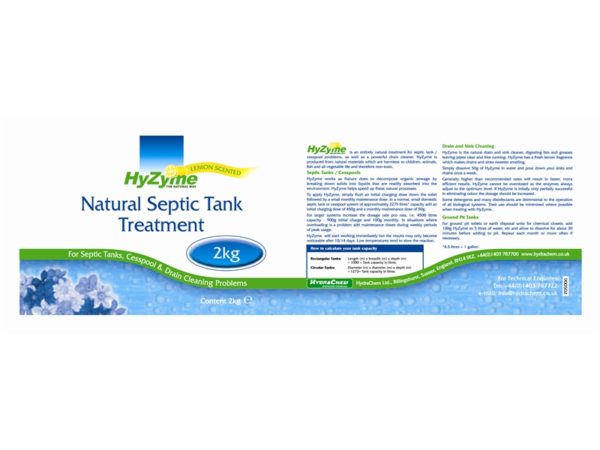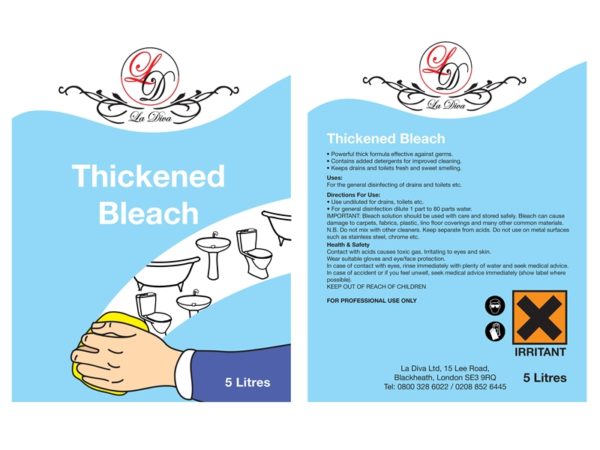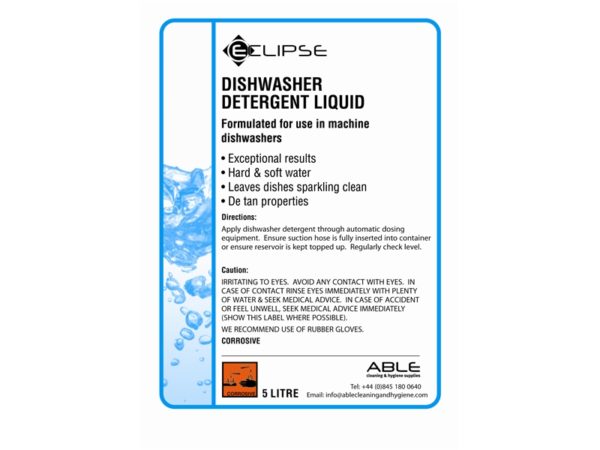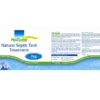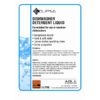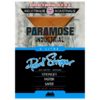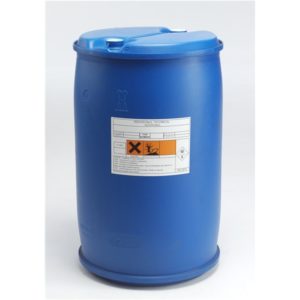Detergents and Disinfectant Labels
Home / Full Product Range / Chemical Labels / Detergents and Disinfectant Labels
Printed bespoke to your requirements, detergent and disinfectant labels can be printed on a range of face papers and adhesives. Please contact us for free samples or a printed proof from your artwork.
Disinfectant and Detergent Labels FAQs
Alcohols:
Alcohols are commonly utilised disinfectants known for their rapid action. The predominant types you might come across are ethanol and isopropanol. These are widely used in hand sanitisers and for surface disinfection.
Aldehydes:
The aldehyde class of disinfectants includes agents like formaldehyde and glutaraldehyde. They are particularly valuable in the medical field for instrument sterilisation and are also used for general surface disinfection.
Chlorine and Chlorine Compounds:
This category encompasses disinfectants like sodium hypochlorite, which most people recognise as household bleach, and calcium hypochlorite. They serve a dual purpose, being effective for both surface disinfection and water treatment processes.
Quaternary Ammonium Compounds (Quats):
Quats, as they’re often referred to, include chemicals such as benzalkonium chloride and cetrimonium bromide. Their versatility makes them suitable for a variety of applications, from surface disinfection to serving as antiseptics in healthcare settings.
Peroxides:
Hydrogen peroxide and peracetic acid are the primary members of this disinfectant category. They’re notable for their role in surface disinfection and sterilisation of medical instruments.
Phenolics:
Phenolic disinfectants, with well-known members like Lysol and triclosan, have long been used for surface disinfection. Additionally, their properties make them suitable as antiseptics in various healthcare environments.
Biguanides:
Chlorhexidine is the most recognised biguanide disinfectant. Its efficacy against a diverse range of bacteria and enveloped viruses has cemented its place in medical applications, notably as skin antiseptics and wound cleansers.
Iodophors:
Povidone-iodine stands out as the primary iodophor disinfectant. It’s renowned for its broad-spectrum activity, making it an ideal choice for skin antiseptics and wound care.
In the UK, the primary body responsible for regulating the information on disinfectant labels, particularly those that claim to kill or control harmful organisms, is the Health and Safety Executive (HSE). The HSE ensures that biocidal products, which include disinfectants, meet the necessary standards for efficacy and human/environmental safety.
Products that claim to be biocidal (i.e., they control harmful organisms) must be authorised under the Biocidal Products Regulation (BPR, Regulation (EU) 528/2012) before they can be placed on the market. The BPR aims to provide a high level of protection for humans and the environment from the possible risks posed by biocides.
If a disinfectant makes specific claims, like being effective against particular bacteria or viruses, it must have the data to support these claims and be compliant with the BPR.
In the UK, under the Biocidal Products Regulation (BPR, Regulation (EU) 528/2012), specific information is required to be displayed on disinfectant labels to ensure user safety and product efficacy. The exact requirements can vary based on the type and intended use of the disinfectant, but in general, the following information is mandated for inclusion:
Product Name: This includes the commercial name of the product and potentially its common name.
Active Ingredients: Display the active substances and their respective concentrations.
Authorisation Number: A unique identifier given to products that have been authorised for sale in the UK under the BPR.
Instructions for Use: Detailed guidance on how and where the product should be used, including any dilution recommendations and contact times.
Precautionary Statements: These are standardised warnings, often labelled as “P statements”, which indicate potential hazards and safe use practices, e.g., “P101 – If medical advice is needed, have product container or label at hand.”
Hazard Statements: Labelled as “H statements”, these indicate the nature of the hazards the product presents, e.g., “H314 – Causes severe skin burns and eye damage.”
Safety Precautions: Including personal protective equipment (PPE) requirements, first-aid measures, and any necessary precautions to ensure user safety.
Storage and Disposal Instructions: Proper storage conditions to maintain product efficacy and safety, along with correct disposal methods to minimise environmental impact.
Batch or Lot Number: For traceability purposes.
Expiry Date: The date after which the product may not guarantee its stated efficacy.
Manufacturer’s or Supplier’s Contact Information: Including name, address, and contact number.
Intended Use: A clear statement of what the disinfectant is designed to be used for, e.g., surface disinfection, hand sanitation, etc.
Warnings: Any necessary warnings regarding potential risks, interactions with other chemicals, or surfaces it should not be used on.
Product Identification: Name of the detergent and its primary purpose.
Manufacturer’s Details: Name, full address, and telephone number of the party responsible for placing the product on the market.
Ingredient Disclosure: Listing of ingredients, particularly Surfactants (e.g., anionic, non-ionic, cationic, and amphoteric surfactants), Phosphates or phosphonates, ingredients such as enzymes, bleaches, and perfumes, especially allergenic fragrances.
Quantity: Amount of detergent in the package (e.g., litres, grams).
Dosage Instructions: Guidance on how much detergent to use based on load size, water hardness, and level of soiling.
Usage Instructions: Directions on how to use the product effectively and safely.
Safety Information: Precautions and warnings related to health, safety, and environment. This may include hazard statements, precautionary statements, and pictograms.
Environmental Information: Guidance or symbols indicating environmental considerations, like biodegradability or recycling information.
Batch or Lot Number: To trace the product for quality control or recall purposes.
Performance Claims: Any efficacy claims, e.g., “removes 99% of stains.”
Storage Instructions: Information about storing the product to maintain efficacy and prevent degradation.
pH Value: Might be mentioned on specialized products to indicate acidity or alkalinity.
The Control of Substances Hazardous to Health (COSHH) regulations in the UK primarily address the responsibilities of employers to ensure the health and safety of their workers when dealing with hazardous substances. COSHH itself doesn’t dictate the specific content of product labels.
Printed bespoke to your requirements, detergent and disinfectant labels can be printed on a range of face papers and adhesives. Please contact us for free samples or a printed proof from your artwork.
Disinfectant and Detergent Labels FAQs
Alcohols:
Alcohols are commonly utilised disinfectants known for their rapid action. The predominant types you might come across are ethanol and isopropanol. These are widely used in hand sanitisers and for surface disinfection.
Aldehydes:
The aldehyde class of disinfectants includes agents like formaldehyde and glutaraldehyde. They are particularly valuable in the medical field for instrument sterilisation and are also used for general surface disinfection.
Chlorine and Chlorine Compounds:
This category encompasses disinfectants like sodium hypochlorite, which most people recognise as household bleach, and calcium hypochlorite. They serve a dual purpose, being effective for both surface disinfection and water treatment processes.
Quaternary Ammonium Compounds (Quats):
Quats, as they’re often referred to, include chemicals such as benzalkonium chloride and cetrimonium bromide. Their versatility makes them suitable for a variety of applications, from surface disinfection to serving as antiseptics in healthcare settings.
Peroxides:
Hydrogen peroxide and peracetic acid are the primary members of this disinfectant category. They’re notable for their role in surface disinfection and sterilisation of medical instruments.
Phenolics:
Phenolic disinfectants, with well-known members like Lysol and triclosan, have long been used for surface disinfection. Additionally, their properties make them suitable as antiseptics in various healthcare environments.
Biguanides:
Chlorhexidine is the most recognised biguanide disinfectant. Its efficacy against a diverse range of bacteria and enveloped viruses has cemented its place in medical applications, notably as skin antiseptics and wound cleansers.
Iodophors:
Povidone-iodine stands out as the primary iodophor disinfectant. It’s renowned for its broad-spectrum activity, making it an ideal choice for skin antiseptics and wound care.
In the UK, the primary body responsible for regulating the information on disinfectant labels, particularly those that claim to kill or control harmful organisms, is the Health and Safety Executive (HSE). The HSE ensures that biocidal products, which include disinfectants, meet the necessary standards for efficacy and human/environmental safety.
Products that claim to be biocidal (i.e., they control harmful organisms) must be authorised under the Biocidal Products Regulation (BPR, Regulation (EU) 528/2012) before they can be placed on the market. The BPR aims to provide a high level of protection for humans and the environment from the possible risks posed by biocides.
If a disinfectant makes specific claims, like being effective against particular bacteria or viruses, it must have the data to support these claims and be compliant with the BPR.
In the UK, under the Biocidal Products Regulation (BPR, Regulation (EU) 528/2012), specific information is required to be displayed on disinfectant labels to ensure user safety and product efficacy. The exact requirements can vary based on the type and intended use of the disinfectant, but in general, the following information is mandated for inclusion:
Product Name: This includes the commercial name of the product and potentially its common name.
Active Ingredients: Display the active substances and their respective concentrations.
Authorisation Number: A unique identifier given to products that have been authorised for sale in the UK under the BPR.
Instructions for Use: Detailed guidance on how and where the product should be used, including any dilution recommendations and contact times.
Precautionary Statements: These are standardised warnings, often labelled as “P statements”, which indicate potential hazards and safe use practices, e.g., “P101 – If medical advice is needed, have product container or label at hand.”
Hazard Statements: Labelled as “H statements”, these indicate the nature of the hazards the product presents, e.g., “H314 – Causes severe skin burns and eye damage.”
Safety Precautions: Including personal protective equipment (PPE) requirements, first-aid measures, and any necessary precautions to ensure user safety.
Storage and Disposal Instructions: Proper storage conditions to maintain product efficacy and safety, along with correct disposal methods to minimise environmental impact.
Batch or Lot Number: For traceability purposes.
Expiry Date: The date after which the product may not guarantee its stated efficacy.
Manufacturer’s or Supplier’s Contact Information: Including name, address, and contact number.
Intended Use: A clear statement of what the disinfectant is designed to be used for, e.g., surface disinfection, hand sanitation, etc.
Warnings: Any necessary warnings regarding potential risks, interactions with other chemicals, or surfaces it should not be used on.
Product Identification: Name of the detergent and its primary purpose.
Manufacturer’s Details: Name, full address, and telephone number of the party responsible for placing the product on the market.
Ingredient Disclosure: Listing of ingredients, particularly Surfactants (e.g., anionic, non-ionic, cationic, and amphoteric surfactants), Phosphates or phosphonates, ingredients such as enzymes, bleaches, and perfumes, especially allergenic fragrances.
Quantity: Amount of detergent in the package (e.g., litres, grams).
Dosage Instructions: Guidance on how much detergent to use based on load size, water hardness, and level of soiling.
Usage Instructions: Directions on how to use the product effectively and safely.
Safety Information: Precautions and warnings related to health, safety, and environment. This may include hazard statements, precautionary statements, and pictograms.
Environmental Information: Guidance or symbols indicating environmental considerations, like biodegradability or recycling information.
Batch or Lot Number: To trace the product for quality control or recall purposes.
Performance Claims: Any efficacy claims, e.g., “removes 99% of stains.”
Storage Instructions: Information about storing the product to maintain efficacy and prevent degradation.
pH Value: Might be mentioned on specialized products to indicate acidity or alkalinity.
The Control of Substances Hazardous to Health (COSHH) regulations in the UK primarily address the responsibilities of employers to ensure the health and safety of their workers when dealing with hazardous substances. COSHH itself doesn’t dictate the specific content of product labels.


